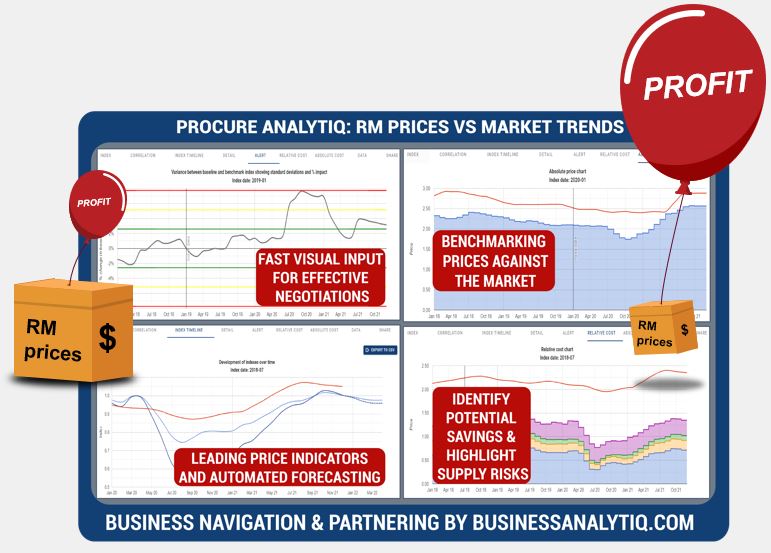Business Analytiq assumes no responsibility or liability for any errors or omissions in the content of this site. The information contained in this site is provided on an “as is” basis with no guarantees of completeness, accuracy, usefulness, or timeliness.
Caustic potash price index
This post is a summary of the Caustic potash price developments. The price developments of Caustic potash are expressed in US$ prices converted FX rates applicable at the time when the price was valid. Caustic potash price index developments are calculated from multiple separate sources of data to ensure statistical accuracy.
The outlook for potassium caustic potash (hydroxide) prices, on the second tab, is generated from different inputs including:
- Very recent price developments of immediate cost drivers of Caustic potash prices
- Recent price developments of underlying feedstocks which drive the price of Caustic potash
- Market futures for both cost drives and feedstocks of Caustic potash prices
- Adjustment of current supply/demand imbalances in the Caustic potash market
- Longer term trends in likely demand conditions
Further information on the Caustic potash price chart
What is Caustic potash
Caustic potash (KOH) is a strong, inorganic base with the chemical formula KOH. It is commonly known as Potassium hydroxide and is a white, odorless solid that is highly soluble in water, forming a strongly alkaline solution.
Caustic potash is used in a wide range of applications, including the production of soap, detergents, and other cleaning products. It is also used in the production of fertilizers, batteries, and certain types of food processing. In addition, potassium hydroxide is used in chemical synthesis, particularly in the manufacture of certain types of pharmaceuticals and other organic compounds.
What is Caustic potash used for
Caustic potash has a wide range of uses in various industries and applications. Here are some of the most common uses of Caustic potash:
Soap and Detergent Production
Caustic potash is commonly used in the production of liquid soaps and detergents. It is a key ingredient that helps to break down and dissolve oils and fats.
Chemical Synthesis
Caustic potash is used in a wide range of chemical reactions, such as the production of certain types of pharmaceuticals and organic compounds.
Food Processing
Caustic potash is used in food processing to help preserve the color, flavor, and texture of certain foods, such as olives and cocoa.
Fertilizer Production
Caustic potash is used in the production of fertilizers, particularly those that contain potassium.
Battery Production
Caustic potash is used in the production of batteries, particularly alkaline batteries.
Cleaning and Disinfecting
Caustic potash is used as a strong cleaning and disinfecting agent, particularly in industrial settings.
pH Adjustment
Caustic potash is often used to adjust the pH of various solutions, particularly in laboratory and industrial settings.
Water Treatment
Caustic potashis used in water treatment to adjust the pH of water and remove impurities.
These are just a few examples of the many uses of Caustic potash in various industries and applications.
What types of Caustic potash are there
Caustic potash is typically available in two forms: liquid and solid. The solid form of Caustic potash is commonly sold as pellets, flakes, or powder, while the liquid form is sold as a solution. Both forms of Caustic potash have similar chemical properties and can be used for similar applications.
In addition to the two main forms, there are also different grades of Caustic potash that are available, depending on the intended use. These grades may differ in terms of their purity, concentration, and physical properties.
Some common types of Caustic potash include:
Industrial Grade
This type of Caustic potash is typically used in industrial applications, such as chemical synthesis, soap and detergent production, and water treatment. It is often less pure and less concentrated than other grades.
Food Grade
This type of Caustic potash is used in food processing and is subject to strict regulations to ensure its safety for use in food products.
Pharmaceutical Grade
This type of Caustic potash is highly pure and is used in the production of pharmaceuticals and other medical products.
Battery Grade
This type of Caustic potash is used in the production of batteries, particularly alkaline batteries, and is often highly concentrated.
These are just a few examples of the different types of Caustic potash that are available
How is Caustic potash produced
Caustic potash can be produced through several methods, including the electrolysis of potassium chloride, the reaction of potassium carbonate with calcium hydroxide, and the reaction of potassium chloride with sodium hydroxide. The most common method for commercial production of Caustic potash is through the electrolysis of potassium chloride.
The electrolysis method involves passing an electric current through a solution of potassium chloride (KCl) and water (H2O), which causes the potassium ions (K+) and the hydroxide ions (OH-) to move towards the respective electrodes. At the anode, chlorine gas is produced, while at the cathode, hydrogen gas is produced and potassium ions combine with the hydroxide ions to form Caustic potash.
The overall reaction can be represented as:
2KCl + 2H2O → 2KOH + H2 + Cl2
The resulting Caustic potash solution is then typically evaporated to produce solid Caustic potash pellets or flakes. The purity of the product can be further improved through additional purification and refining steps, depending on the intended use of the potassium hydroxide.
What drives the cost of Caustic potash
Several factors can affect the cost of Caustic potash, including the cost of raw materials, production costs, transportation costs, and market demand.
The cost of raw materials, particularly the cost of Caustic potash, which is the primary raw material used in the production of Caustic potash, can have a significant impact on the cost of Caustic potash. Changes in the availability and price of potassium chloride can impact the cost of producing Caustic potash, and thus, affect the market price of the product.
Production costs, such as labor, energy, and equipment costs, can also impact the cost of Caustic potash. Changes in production efficiency or input costs can affect the overall cost of producing Caustic potash.
Transportation costs, such as shipping, handling, and storage costs, can also impact the cost of Caustic potash, particularly if the product needs to be transported over long distances.
Finally, market demand can also affect the cost of Caustic potash. Changes in demand, particularly in industries such as soap and detergent production or chemical synthesis, can impact the market price of the product. Factors such as economic growth, industrialization, and changes in consumer preferences can all impact the demand for Caustic potash and its price.
How big is the global Caustic potash market
The global Caustic potash market size was valued at around USD 2.5 billion in 2020 and is projected to reach USD 3.6 billion by 2027, with a compound annual growth rate (CAGR) of around 5.1% from 2021 to 2027, according to a report by Grand View Research. The increasing demand for Caustic potash in various industries, such as chemical synthesis, soaps and detergents, food processing, and water treatment, is driving the growth of the market. Additionally, the growing demand for Caustic potash in emerging economies and the increasing use of Caustic potash in the production of batteries and fertilizers are also contributing to the growth of the market.
According to https://oec.world/ :
Potassium hydroxide (caustic potash) are the world’s 2325th most traded product.
In 2020, the top exporters of Potassium hydroxide (caustic potash) were South Korea ($151M), Belgium ($147M), United States ($79.9M), Czechia ($42M), and China ($40.2M).
In 2020, the top importers of Potassium hydroxide (caustic potash) were Germany ($74.3M), Israel ($42.5M), France ($36.2M), Malaysia ($35.4M), and Netherlands ($30.5M).
Which countries produce the most Caustic potash
The top Caustic potash producing countries in the world are China, the United States, and Russia.
China is the largest producer of potassium hydroxide, accounting for around 60% of the global production. The country has a significant presence in the market due to its large population and growing industrialization.
The United States is the second-largest producer of potassium hydroxide, with a share of around 10% of the global production. The country has a well-established chemical industry and is a major exporter of potassium hydroxide.
Russia is the third-largest producer of potassium hydroxide, with a share of around 8% of the global production. The country has significant reserves of potassium salts, which are used as a raw material for the production of potassium hydroxide.
Other significant potassium hydroxide producing countries include Canada, Germany, Japan, and South Korea.
Further information
Business Analytiq
BE THE FIRST TO SEE RISK AND OPPORTUNITY!
BusinessAnalytiq provides unlimited market trend data and an online tools to track market developments, key benchmarks & leading indicators.
BusinessAnalytiq leads to price visibility, better negotiations, easier budgeting and forecasting, lower raw material prices, and improved better internal and external communication. BusinessAnalytiq will decrease risk and higher profit.

Where does the data come from?
- The source of the data are exclusively public non-confidential sources. We have no access to primary data
- This the index trend of the price trend of the "product category" in general, and not a single specification of the product in particular
- The data is a combination of contract and spot pricing
- Our algorithms are set up to eliminate significant product mix impact on the reported price
- We combine public publications, import/export records, trading prices, company announcements, magazine articles, tweets, and other sources of ad-hoc public information.
- The chart shows the our best approximation of the market trend based on our algorithm interpretation of the signals
- For most indexes we have multiple sources and we focus on using statistically-correlated sources
- As a function of our automation, it is likely that recent trends will be adjusted as we discover more information. So, for example, the price trend for February 2024 will be first calculated in February 2024 and adjusted in March, April and May 2024.
- We will update the data trend as more information becomes available, and this means that recent trends will always be adjusted as we get more data available
- The algorithm will regularly revise our understanding of market trends, and indicated market trends may change
- The data is presented in US$. The UOM of measure is shown in the Index list table
- Our automated software and we do our best to create an accurate representation of the trend
Where does the data NOT come from?
- We do not purchase data from any other source and republish it.
- We will not purchase data from any other source and republish it
- We do not extrapolate trends, even for the forecast. We look for other market signals and leading indicators
What data should our company use?
- If you are making decisions driving significant share of profit, we always recommend that you buy data from the companies who invest in direct primary market access such as ICIS, amongst many others
- Our data, at best, represents an estimate of the market trend based on public information
- We have no direct access to the market, and we do not interview suppliers and customers
- Our automated analysis tools in the online software are set up to combine our data with other sources of data
- We do not recommend that you use our data for direct price mechanisms, as we may change and improve the data trends over time, including historical data
What does the quality indication in the main menu mean?
- Quality level A: Data is from a reliable and confirmed source
- Quality level B: Data is from multiple credible sources and there are no major statistical inconsistencies between them
- Quality level C: Data is from multiple credible sources and there are some statistical inconsistencies between them
- Quality level D: Data is from a single credible source, but we cannot verify the data
- Quality level E: Data is either:
- From a single source, which we consider reliable, but we cannot verify the data.
- From 2 or more sources which have some periods of contradicting trends.
- Quality level F: Data is from a single source which we consider indicatively correct, but the data is anecdotal and we cannot verify the data.
What are the disclaimers?
- We assume no responsibility or liability for any errors or omissions in the content of this site.
- The information is provided on an “as is” basis with no guarantee of completeness, accuracy, usefulness, fitness for purpose or timeliness.
- By their nature, outlooks are always uncertain
How often do we update the data?
- We aim to update the data series on the 9th and 24th of each month (but we do not always make it for each chart)
- The data for the current month and recent history are fine-tuned over time.
What are we doing to improve the data?
- We are continually improving our data collection and processing methods
- Pricing data will be updated from time to time as we improve the accuracy
- We are reviewing all data sources in the first half of 2024.
- There will be continuous fine-tuning of the trend and forecast algorithm as part of that.
- The key focus in 2024 is to add many additional indexes
How can i give feedback on the data or request for new indexes
- Feel free to contact us if you have a specific request. You can reach us via the Contact us page

